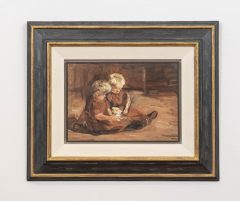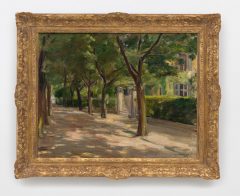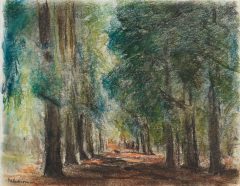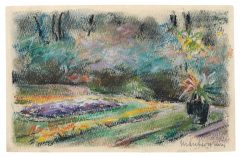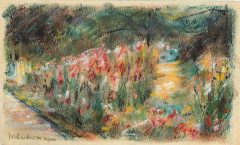Max Liebermann
Spielende Kinder in einer Scheune
1898
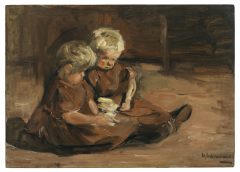
Oil on canvas on cardboard
33 × 48 cm | 13 × 19 in
Signed
Catalogue Raisonné by Eberle 1995 no. 1898/9
The artist's studio; Collection Dr. J. Deutsch, Munich (until 1931); Galerie Hugo Helbing, Munich; Private Collection Basel (since 1937); Private Collection Geneva
- Kunsthalle Bern, "Albert Welti - Max Liebermann", Bern 1937
- Galerie Helbing, "Sammlung Dr. J. Deutsch: Ölgemälde des IXX. und XX. Jahrhunderts", München 1931
- Matthias Eberle, "Max Liebermann. Werkverzeichnis der Gemälde und Ölstudien 1865-1899", Bd. I, München 1995, no. 1898/9
- Kunsthalle Bern, "Albert Welti – Max Liebermann", Ausst.-Kat., Bern 1937, no. 154
- Hugo Helbing, "Sammlung Dr. J. Deutsch: Ölgemälde des IXX. und XX. Jahrhunderts", Ausst.-Kat., München 1931, plate 31, ill. 84
- Berliner Illustrirte Zeitung, Berlin 25.6.1899, p. 5
Max Liebermann's early creative years were characterised by a thoroughly resistant attitude. Liebermann consciously positioned himself against the artistic taste of the Wilhelmine Empire, which was orientated towards the tradition of the Academy. Art should be the great story, not the artist's brushwork. Liebermann wanted to reject the claim of pathos, epic history paintings or delightful genre scenes and sought and found his artistic patrons in French painting. Artists such as Jean Francois Millet, Gustave Courbet and Edgar Degas had a decisive influence on Liebermann's understanding of art. He praised Degas' works in 1889, saying that they were created - quite by chance - and not made.1 Liebermann discovered a suitable form of expression in the rural realism of peasant simplicity that he found in these paintings. From 1876 onwards, he travelled back to Holland, where he spent the summer months in villages such as Dongen, Zweelo and Laren. What he discovered there and what fascinated him were everyday motifs that inspired him to create a new style of painting: Villagers working at home and in the fields, family get-togethers or living together in old men's homes and orphanages. Visibly moved by the strong cohesion of the village communities, he wrote to his brother Felix: There is no poverty here. 2
Our painting from 1898 is a particularly beautiful example of this creative period and also represents a striking change in Liebermann's work. The picture shows two immersed girls playing together in a barn. The scene reveals a moment of lightheartedness. The earthy coloring of the early years and the tone-in-tone painting are still used here. But Liebermann's impressionistic gesture is already very clear in the picture. Instead of thin glazes, the paint is quickly applied to the painting surface in a paste-like manner, in which the details lose themselves in favour of the mood. Thus it remains open what the children are actually occupied with. Despite the covered palette, the shades of brown and red are friendly and achieve a haptic quality. In the middle of the picture, the children's blond creatures shine like two light sources. Looking at the pictures of the following year, in which Liebermann, as a reaction to his bad critiques, finally exchanges the peasant staff of his pictures for polo players, bathers and riders on the beach, this painting seems like a silent farewell greeting. A last joyful look at the old painting and the time spent together in the village, in the knowledge that artists must never remain. The fact that Liebermann is to be called the "Manet of the Germans" in the future is already very clear in this painting.
1 Max Liebermann. Degas, Berlin: Cassirer, 1899, p. 11.
2 Tobias Natter, Julias H. Schoeps (eds.), "Max Liebermann and the French Impressionists", Cologne 1997, p. 39.
